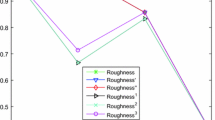Abstract
Non-symmetric similarity relation-based rough set model (NS-RSM) is viewed as mathematical tool to deal with the analysis of imprecise and uncertain information in incomplete information systems with “?” values. NS-RSM relies on the concept of non-symmetric similarity relation to group equivalent objects and generate knowledge granules that are then used to approximate the target set. However, NS-RSM results in unpromising approximation space when addressing inconsistent data sets that have lots of boundary objects. This is because objects in the same similarity classes are not necessarily similar to each other and may belong to different target classes. To enhance NS-RSM capability, we introduce the maximal limited similarity-based rough set model (MLS-RSM) which describes the maximal collection of indistinguishable objects that are limited tolerance to each other in similarity classes. This allows accurate computation to be done for the approximation space. Furthermore, approximation accuracy comparisons have been conducted among NS-RSM and MLS-RSM. The results demonstrate that MLS-RSM model outperforms NS-RSM and can approximate the target set more efficiently.
Similar content being viewed by others
Explore related subjects
Discover the latest articles, news and stories from top researchers in related subjects.References
Cheng YS, Zhang YS, Hu XG, Zhang YZ (2007) Uncertainty measure of knowledge and rough set based on maximal consistency block technique. In: Proceedings of the sixth international conference on machine learning and cybernetics, Hong Kong, pp 3069–3074
Dai J, Xu Q (2012) Approximations and uncertainty measures in incomplete information systems. Inf Sci 198:62–80
DU WF, ZI T (2014) Properties of lower and upper approximation operators under various kinds of relations. In: International conference on mechanics and civil engineering, pp 472–477
Gantayat SS, Misra A, Panda BS (2014) A study of incomplete data—a review. In: Advances in intelligent systems and computing, proceedings of the international conference on frontiers of intelligent computing: theory and applications (FICTA), vol 247, pp 401–408
Grzymała-Busse JW (2004) Characteristic relations for incomplete data: a generalization of the indiscernibility relation. In: Lecture notes in computer science. Proceeding of the fourth international conference on rough sets and current trends in computing, vol 3066, pp 244–253
Grzymala-Busse JW, Hu M (2005) A comparison of several approaches to missing attribute values in data mining. In: Lecture notes in computer science, proceedings of the second international conference on rough sets and current trends in computing. Springer, Berlin, pp 378–385
Grzymala-Busse JW, Wang A (1997) Modified algorithms lem1 and lem2 for rule induction from data with missing attribute values. In: Machine learning and cybernetics communications in computer and information science, proceeding of the fifth international workshop on rough sets and soft computing at the third joint conference on information sciences, pp 69–72
Huang J, Guan Y, Shen J, Wang H (2014) Rough approximations in tolerance rough set models. In: 11th International conference on fuzzy systems and knowledge discovery, pp 61–66
Huang S, Li M (2014) Limited and variable precision rough set model. J Inf Comput Sci 11:3493–3501
Jensen R, Tusonb A, Shena Q (2014) Finding rough and fuzzy-rough set reducts with sat. Inf Sci 225:100–120
Jiang Y, Yu Y (2015) Minimal attribute reduction with rough set based on compactness discernibility information tree. Soft Comput 20:2233–2243
Kryszkiewicz M (1998) Rough set approach to incomplete information system. Inf Sci 112:39–49
Kryszkiewicz M (1999) Rules in incomplete information systems. Inf Sci 113:271–292
Leung Y, Li D (2003) Maximal consistent block technique for rule acquisition in incomplete information systems. Inf Sci 153:85–106
Liu X, Shao M (2014) Approachs to computing maximal consistent block. Machine Learning and Cybernetics Communications in Computer and Information Science 481:264–274
Nguyen DV, Yamada K, Unehara M (2013) Extended tolerance relation to define a new rough set model in incomplete information systems. Adv Fuzzy Syst 13:1–10
Pawlak Z (1982) Rough sets. Int J Inf Comput Sci 11:341–356
Qin B, Xia G, Yan K (2015) Similarity of binary relations based on rough set theory and topology: an application for topological structures of matroids. Soft Comput 20:853–861
Skowron A, Stepaniuk J (1996) Tolerance approximation space. Fundam Inform 27:245–253
Słowiński R, Greco S, Matarazzo B (2014) Rough-set-based decision support. In: Burke EK, Kendall G (eds) Search methodologies. Springer, pp 475–527
Stefanowski J, Tsoukiàs A (1999) On the extension of rough sets under incomplete information. In: Lecture notes in computer science, 7th international workshop on new directions in rough sets, data mining, and granular-soft computing, vol 1711, pp 73–81
Stefanowski J, Tsoukiàs A (2001) Incomplete information tables and rough classification. Comput Intell 17:545–566
Team W (2015) Knowledge extraction based on evolutionary learning. http://sci2s.ugr.es/keel/missing.php
UCI (2015) Uci machine learning repository. https://archive.ics.uci.edu/ml/index.html
Wang G (2001) Rough set theory and knowledge acquisition. Xi’an Jiaotong University Press, Xi’an
Wang G (2002) Extension of rough set under incomplete information systems*. Fuzzy systems, 2002. FUZZ-IEEE’02. In: Proceedings of the IEEE international conference 2, pp 1098–1103
Wang G, Guan L, Hu F (2008) Rough set extensions in incomplete information systems. Front Electr Electron Eng China 3:399–405
Yang X (2009) Difference relation-based rough set and negative rules in incomplete information system. Int J Uncertain Fuzziness Knowl Based Syst 18:649–665
Yang X, Yang J (2012) Expansions of rough sets in incomplete information systems. Science Press, Beijing
Yin X, XiuyiJia Shang L (2006) A new extension model of rough sets under incomplete information, vol 4062. Springer, Berlin
Acknowledgments
The authors would like to thank the editors and the anonymous reviewers for their valuable comments and suggestions which helped immensely in improving the quality of the paper.
Funding This study is not funded by any organization.
Author information
Authors and Affiliations
Corresponding author
Ethics declarations
Conflict of interest
The three authors declare that they have no conflict of interest.
Ethical approval
This article does not contain any studies with human or animal participants performed by any of the authors.
Additional information
Communicated by A. Di Nola.
Rights and permissions
About this article
Cite this article
Attia, A.H., Sherif, A.S. & El-Tawel, G.S. Maximal limited similarity-based rough set model. Soft Comput 20, 3153–3161 (2016). https://doi.org/10.1007/s00500-016-2243-6
Published:
Issue Date:
DOI: https://doi.org/10.1007/s00500-016-2243-6




